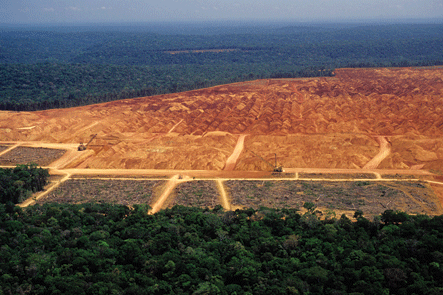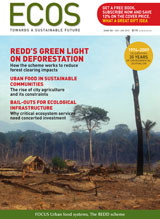
|
Published:
The REDD approach to protecting green carbon
Deforestation causes ~20 per cent of the world’s greenhouse gas emissions and catastrophic climate change will be difficult to avoid unless forest-clearing in the tropics is significantly reduced. Until now, halting deforestation, particularly in developing countries, has been an intractable problem, but as Alexandra de Blas reports, a new approach that may leverage off the evolving global carbon market is holding more promise.
REDD (Reduced Emissions from Deforestation and Forest Degradation) will be one of the key policies negotiated at the United Nations climate conference in Copenhagen in December and could be one of the more positive outcomes to emerge from the contentious meeting.
The concept of reducing emissions from deforestation in developing countries was first introduced by the Governments of Papua New Guinea and Costa Rica at the 11th Conference of the Parties (COP 11) in 2005. It was then incorporated into the Bali Action Plan at COP 13, in 2007, which formed the roadmap for the new agreement to be thrashed out in Copenhagen – COP 15.
The Intergovernmental Panel on Climate Change reported in 2007 that reducing and/or preventing deforestation will have the largest and most immediate impact on carbon stocks in the short-term. REDD is considered a vital policy tool because, on the one hand, it will mitigate climate change, while on the other it will reduce species loss from habitat destruction and provide new avenues for sustainable development.
The action plan provides a mandate for countries to strengthen and support ongoing efforts to reduce emissions from deforestation and degradation, as well as to support capacity-building and technology transfer to developing countries. It encourages nations to explore a range of actions and demonstration activities, and to mobilise additional funds. The financial flows from emission reductions from REDD are forecast to reach up to US$30 billion a year.
REDD will give standing forests a new value – allowing forest protection to compete against a plethora of other pressures. In the long-term, this value is likely to expand to other sources of terrestrial carbon such as agricultural soils, peat and large-scale tree-planting.
Many experts see REDD primarily as a market-based mechanism that will help poor countries to slow deforestation by enabling aid organisations, NGOs, corporations and governments to buy credits generated from activities that protect forests. The buyers could then apply the credits towards their own quotas or trade them in carbon markets.
But the Bali Action Plan defines it more broadly than this. It encourages developing and developed countries to explore a range of actions to address the drivers of deforestation, provided they are measurable, reportable and verifiable. As the Washington-based think-tank, the World Resources Institute, points out in its 2009 report, ‘Beyond carbon financing’,1 a broader set of metrics are needed to account for REDD activities.
For instance, support for sustainable development projects that could help countries clarify land tenure, build fire fighting capabilities or track the legality of wood products could all achieve positive and important REDD outcomes. But a carbon-financing framework, which measures results in terms of tonnes of carbon not emitted, would be inappropriate for these activities.
NGOs such as Greenpeace are opposed to the inclusion of REDD offset credits in the carbon market and argue that a separate mechanism is needed to deal with the complexities and risks associated with REDD. Greenpeace’s report, ‘The economics of 2°C and REDD in carbon markets’,2 claims that including forest offset credits in the carbon market would crash the price for carbon and reduce investments in clean and renewable technologies in both developed and developing countries.

|
|
Local timber mill operations, such as this one along the Amazon River, provide income and livelihoods, but also a market for illegal logging operations. Credit: iStockphoto
|
‘Australia is pushing for a market mechanism too early,’ says Paul Winn, an Australian climate forest campaigner seconded to Greenpeace International. ‘Countries like Indonesia or the Democratic Republic of Congo, who don’t have strong governance structures, may well give the appearance of emission reductions while those reductions aren’t real.’
There is also concern that emission reductions from preventing deforestation are not as reliably permanent or stable as reductions, say, from decommissioning a coal-fired power station. Forests can burn, suffer insect attack or as the climate warms become net emitters of carbon; while emission reductions from diminished fossil fuel use are permanent, stable and more verifiable.

|
|
Mining activity, such as for bauxite, cuts out large swathes of forest in the Amazon region Credit: iStockphoto
|
Fiona McKenzie, a policy advisor with the International Terrestrial Carbon Group, disagrees with Winn’s take on market mechanisms. She believes developing countries will have sufficient time to adjust by 2013 when the international emissions trading system is expected to start. While Winn is concerned that corporations will cream off profits that should be going directly to emissions reductions or forest dependent communities, McKenzie sees the opportunity for generating extra funds and drawing on the efficiencies of the private sector.
If REDD credits are integrated into an international emissions trading system, many argue they should be seen as additional to a country’s emission reductions from fossil fuels. Otherwise we could end up ‘shuffling the deck chairs’ with no real reductions overall. One approach could be a cap on the number of REDD credits a country can count within its national target, or alternatively national targets could be tightened to compensate for forest-based credits.
At the final hour, several hotly debated issues in the REDD policy remain unresolved. One of the most concerning for NGOs is the definition of a forest. The draft text going in to COP 15 currently fails to adequately distinguish between natural forests and plantations. Classifying plantations as forests means that countries such as Indonesia could potentially receive REDD funding to convert native forest to palm oil plantation – resulting in a net loss of carbon and biodiversity. Paul Winn says: ‘We see biodiversity as a core-benefit, not a co-benefit of REDD. Natural forests have a much greater resilience to climate change and are a much more permanent store of carbon.’
At the practical level, demonstration and ‘REDD readiness’ projects are already underway. The UN-REDD Program, established in July 2008, is a collaboration between the Food and Agriculture Organization, the United Nations Development Program and the United Nations Environment Programme. Norway and Denmark have donated funds and 14 developing countries are involved. In its first year, US$37.4 million in funds were approved, and of the six countries whose programs have been signed off, the Democratic Republic of Congo, Tanzania and Vietnam have started activities to get ready for REDD.
The AU$200 million International Forest Carbon Initiative is part of Australia’s contribution to REDD. Taking practical action is central to the initiative, and this is being facilitated through collaborative Forest Carbon Partnerships with Indonesia and Papua New Guinea. Australia is also working with these partners, and countries such as China, to improve forest carbon monitoring and accounting. The lessons learned from its demonstration projects inform Australia’s position on how REDD can be included in a post-2012 global climate agreement.
Clearly, formulating REDD policy is a complex business and reaching actionable agreement in Copenhagen will be a challenge. But success would be a critical step forward in achieving not just a safer climate scenario, but security of biodiversity too.
More information:
UN-REDD Program, http://www.un-redd.org/UNREDDProgramme/tabid/583/language/en-US/Default.aspx
International Forest Carbon Initiative, http://www.climatechange.gov.au/government/initiatives/international-forest-carbon-initiative.aspx
1 http://www.wri.org/publication/beyond-carbon-financing
2 http://www.greenpeace.org/international/press/reports/the-economics-of-redd-summary




